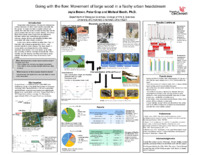Going With the Flow Movement of Large Wood in a Flashy Urban Headstream
Main Article Content
Abstract
By Jayla Brown, Biological Sciences - Animal Biology; Peter Grap, University of Cincinnati
Advisor: Michael Booth
Presentation ID: 142
Abstract: Pieces of large wood in streams create crucial habitat features, slowing water velocity and encouraging the development of deeper, more connected pools. These stream characteristics create better habitats for aquatic life inhabiting the ecosystem. If wood moves frequently, these structural benefits cannot develop. The purpose of this project was to analyze the movement of large woody debris in Cooper Creek-a stream running through Bechtold Park in Sycamore Township, Ohio. Through this project we hoped to discover how stability and structural characteristics of wood impact their mobility. The large woody debris in the stream was mapped to the nearest meter, characterized with categories pertaining to size, alignment, stability, and individually marked using passive integrated transponders for identification purposes. After each storm event, we relocated each individual piece of wood and characterized any movements or changes. Streamflow was measured using an electromagnetic flow meter and continuously recording water level loggers to track the magnitude of storm related flows. By tracking the movements- or lack thereof - of pieces of wood, we were able to associate characteristics with the tendency to move. Pieces secured by other pieces of a larger jam or wedged behind standing trees were stable, while pieces freely sitting in the stream or within the water surface moved. There was not a relationship between structure and movement. We couldn't evaluate a relationship between discharge of storm events and movement due to the limited number of storm events. This project will provide helpful insight for improving habitat in urban headwater streams.
